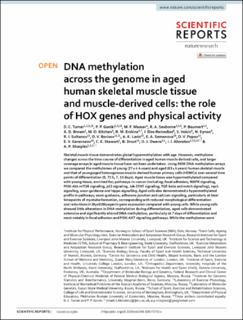| dc.description | This article is licensed under a Creative Commons Attribution 4.0 International License, which permits use, sharing, adaptation, distribution and reproduction in any medium or format, as long as you give appropriate credit to the original author(s) and the source, provide a link to the Creative Commons licence, and indicate if changes were made. The images or other third party material in this article are included in the article's Creative Commons licence, unless indicated otherwise in a credit line to the material. If material is not included in the article's Creative Commons licence and your intended use is not permitted by statutory regulation or exceeds the permitted use, you will need to obtain permission directly from the copyright holder. | en_US |
| dc.description.abstract | Skeletal muscle tissue demonstrates global hypermethylation with age. However, methylome changes across the time-course of differentiation in aged human muscle derived cells, and larger coverage arrays in aged muscle tissue have not been undertaken. Using 850K DNA methylation arrays we compared the methylomes of young (27 ± 4.4 years) and aged (83 ± 4 years) human skeletal muscle and that of young/aged heterogenous muscle-derived human primary cells (HDMCs) over several time points of differentiation (0, 72 h, 7, 10 days). Aged muscle tissue was hypermethylated compared with young tissue, enriched for; pathways-in-cancer (including; focal adhesion, MAPK signaling, PI3K-Akt-mTOR signaling, p53 signaling, Jak-STAT signaling, TGF-beta and notch signaling), rap1-signaling, axon-guidance and hippo-signalling. Aged cells also demonstrated a hypermethylated profile in pathways; axon-guidance, adherens-junction and calcium-signaling, particularly at later timepoints of myotube formation, corresponding with reduced morphological differentiation and reductions in MyoD/Myogenin gene expression compared with young cells. While young cells showed little alterations in DNA methylation during differentiation, aged cells demonstrated extensive and significantly altered DNA methylation, particularly at 7 days of differentiation and most notably in focal adhesion and PI3K-AKT signalling pathways. While the methylomes were vastly different between muscle tissue and HDMCs, we identified a small number of CpG sites showing a hypermethylated state with age, in both muscle tissue and cells on genes KIF15, DYRK2, FHL2, MRPS33, ABCA17P. Most notably, differential methylation analysis of chromosomal regions identified three locations containing enrichment of 6–8 CpGs in the HOX family of genes altered with age. With HOXD10, HOXD9, HOXD8, HOXA3, HOXC9, HOXB1, HOXB3, HOXC-AS2 and HOXC10 all hypermethylated in aged tissue. In aged cells the same HOX genes (and additionally HOXC-AS3) displayed the most variable methylation at 7 days of differentiation versus young cells, with HOXD8, HOXC9, HOXB1 and HOXC-AS3 hypermethylated and HOXC10 and HOXC-AS2 hypomethylated. We also determined that there was an inverse relationship between DNA methylation and gene expression for HOXB1, HOXA3 and HOXC-AS3. Finally, increased physical activity in young adults was associated with oppositely regulating HOXB1 and HOXA3 methylation compared with age. Overall, we demonstrate that a considerable number of HOX genes are differentially epigenetically regulated in aged human skeletal muscle and HDMCs and increased physical activity may help prevent age-related epigenetic changes in these HOX genes. | en_US |
